National Health Service: Analyzing Factors, Changes and Funding Impact
VerifiedAdded on 2023/06/13
|9
|2976
|186
Report
AI Summary
This report provides a comprehensive analysis of the National Health Service (NHS) in the UK, exploring the factors that led to its creation, its responses to changing demands, and the impact of funding changes over the last 25 years. It discusses the historical context of healthcare provision for low-income individuals, the principles underlying the NHS, and its commitment to providing cost-free care based on clinical needs. The report also examines how the NHS adapts to increasing population, ageing demographics, and the rise of non-communicable diseases, highlighting the challenges faced by emergency care departments and the need for better community support. Furthermore, it analyzes the fluctuations in NHS funding since its inception in 1948, noting periods of growth and decline and their implications for service delivery. The report concludes by emphasizing the importance of addressing funding challenges to ensure effective and accessible healthcare for all.

National Health Service.
Paraphrase This Document
Need a fresh take? Get an instant paraphrase of this document with our AI Paraphraser
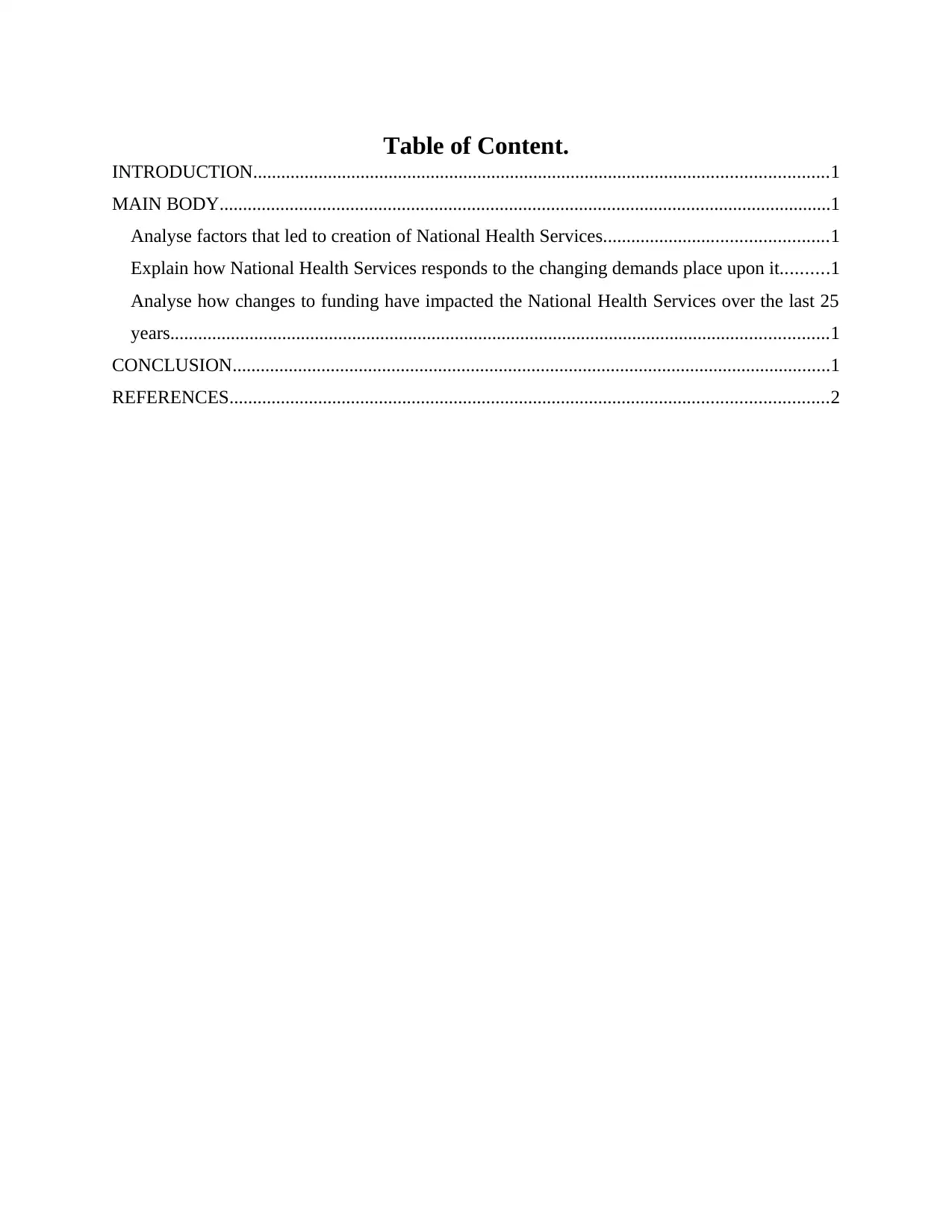
Table of Content.
INTRODUCTION...........................................................................................................................1
MAIN BODY...................................................................................................................................1
Analyse factors that led to creation of National Health Services................................................1
Explain how National Health Services responds to the changing demands place upon it..........1
Analyse how changes to funding have impacted the National Health Services over the last 25
years.............................................................................................................................................1
CONCLUSION................................................................................................................................1
REFERENCES................................................................................................................................2
INTRODUCTION...........................................................................................................................1
MAIN BODY...................................................................................................................................1
Analyse factors that led to creation of National Health Services................................................1
Explain how National Health Services responds to the changing demands place upon it..........1
Analyse how changes to funding have impacted the National Health Services over the last 25
years.............................................................................................................................................1
CONCLUSION................................................................................................................................1
REFERENCES................................................................................................................................2
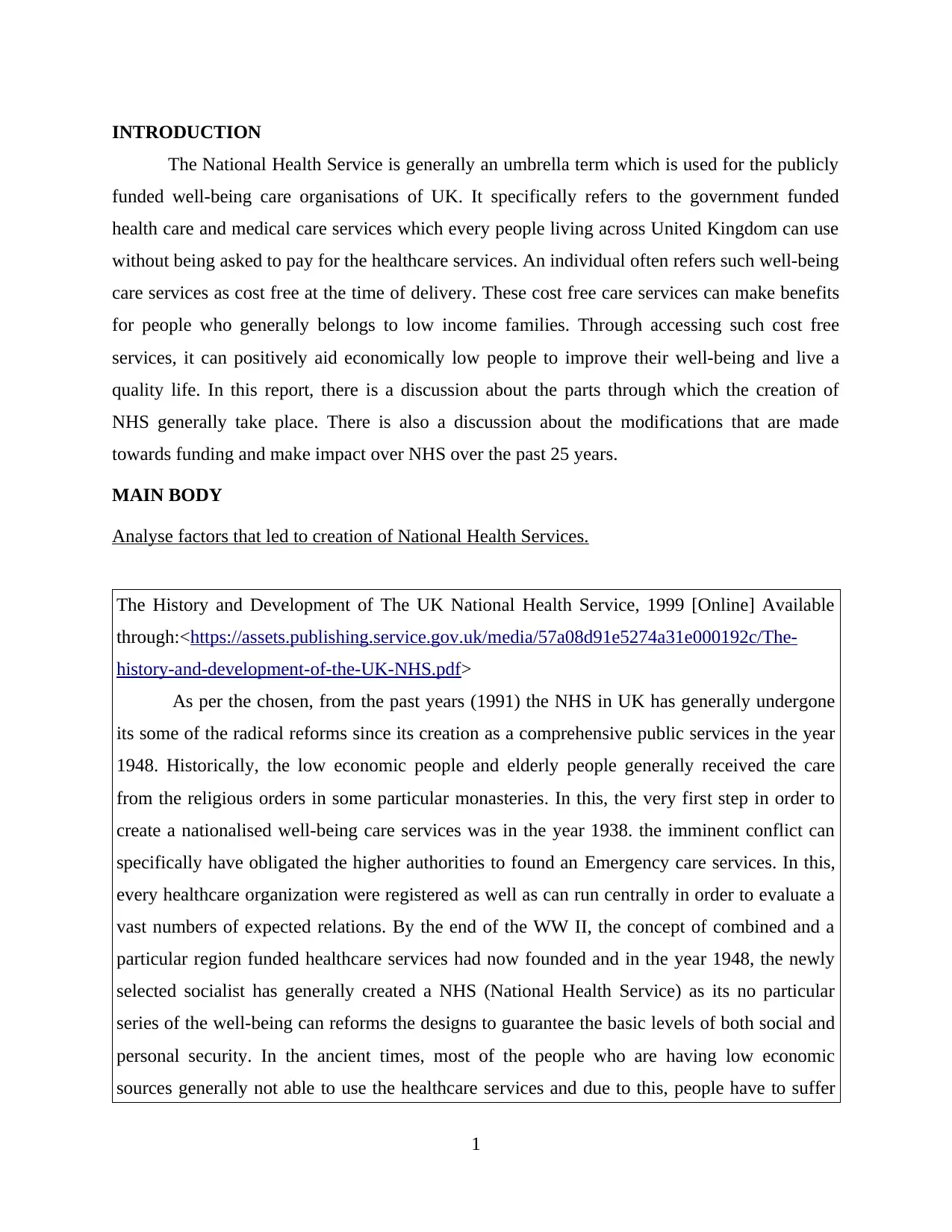
INTRODUCTION
The National Health Service is generally an umbrella term which is used for the publicly
funded well-being care organisations of UK. It specifically refers to the government funded
health care and medical care services which every people living across United Kingdom can use
without being asked to pay for the healthcare services. An individual often refers such well-being
care services as cost free at the time of delivery. These cost free care services can make benefits
for people who generally belongs to low income families. Through accessing such cost free
services, it can positively aid economically low people to improve their well-being and live a
quality life. In this report, there is a discussion about the parts through which the creation of
NHS generally take place. There is also a discussion about the modifications that are made
towards funding and make impact over NHS over the past 25 years.
MAIN BODY
Analyse factors that led to creation of National Health Services.
The History and Development of The UK National Health Service, 1999 [Online] Available
through:<https://assets.publishing.service.gov.uk/media/57a08d91e5274a31e000192c/The-
history-and-development-of-the-UK-NHS.pdf>
As per the chosen, from the past years (1991) the NHS in UK has generally undergone
its some of the radical reforms since its creation as a comprehensive public services in the year
1948. Historically, the low economic people and elderly people generally received the care
from the religious orders in some particular monasteries. In this, the very first step in order to
create a nationalised well-being care services was in the year 1938. the imminent conflict can
specifically have obligated the higher authorities to found an Emergency care services. In this,
every healthcare organization were registered as well as can run centrally in order to evaluate a
vast numbers of expected relations. By the end of the WW II, the concept of combined and a
particular region funded healthcare services had now founded and in the year 1948, the newly
selected socialist has generally created a NHS (National Health Service) as its no particular
series of the well-being can reforms the designs to guarantee the basic levels of both social and
personal security. In the ancient times, most of the people who are having low economic
sources generally not able to use the healthcare services and due to this, people have to suffer
1
The National Health Service is generally an umbrella term which is used for the publicly
funded well-being care organisations of UK. It specifically refers to the government funded
health care and medical care services which every people living across United Kingdom can use
without being asked to pay for the healthcare services. An individual often refers such well-being
care services as cost free at the time of delivery. These cost free care services can make benefits
for people who generally belongs to low income families. Through accessing such cost free
services, it can positively aid economically low people to improve their well-being and live a
quality life. In this report, there is a discussion about the parts through which the creation of
NHS generally take place. There is also a discussion about the modifications that are made
towards funding and make impact over NHS over the past 25 years.
MAIN BODY
Analyse factors that led to creation of National Health Services.
The History and Development of The UK National Health Service, 1999 [Online] Available
through:<https://assets.publishing.service.gov.uk/media/57a08d91e5274a31e000192c/The-
history-and-development-of-the-UK-NHS.pdf>
As per the chosen, from the past years (1991) the NHS in UK has generally undergone
its some of the radical reforms since its creation as a comprehensive public services in the year
1948. Historically, the low economic people and elderly people generally received the care
from the religious orders in some particular monasteries. In this, the very first step in order to
create a nationalised well-being care services was in the year 1938. the imminent conflict can
specifically have obligated the higher authorities to found an Emergency care services. In this,
every healthcare organization were registered as well as can run centrally in order to evaluate a
vast numbers of expected relations. By the end of the WW II, the concept of combined and a
particular region funded healthcare services had now founded and in the year 1948, the newly
selected socialist has generally created a NHS (National Health Service) as its no particular
series of the well-being can reforms the designs to guarantee the basic levels of both social and
personal security. In the ancient times, most of the people who are having low economic
sources generally not able to use the healthcare services and due to this, people have to suffer
1
⊘ This is a preview!⊘
Do you want full access?
Subscribe today to unlock all pages.

Trusted by 1+ million students worldwide
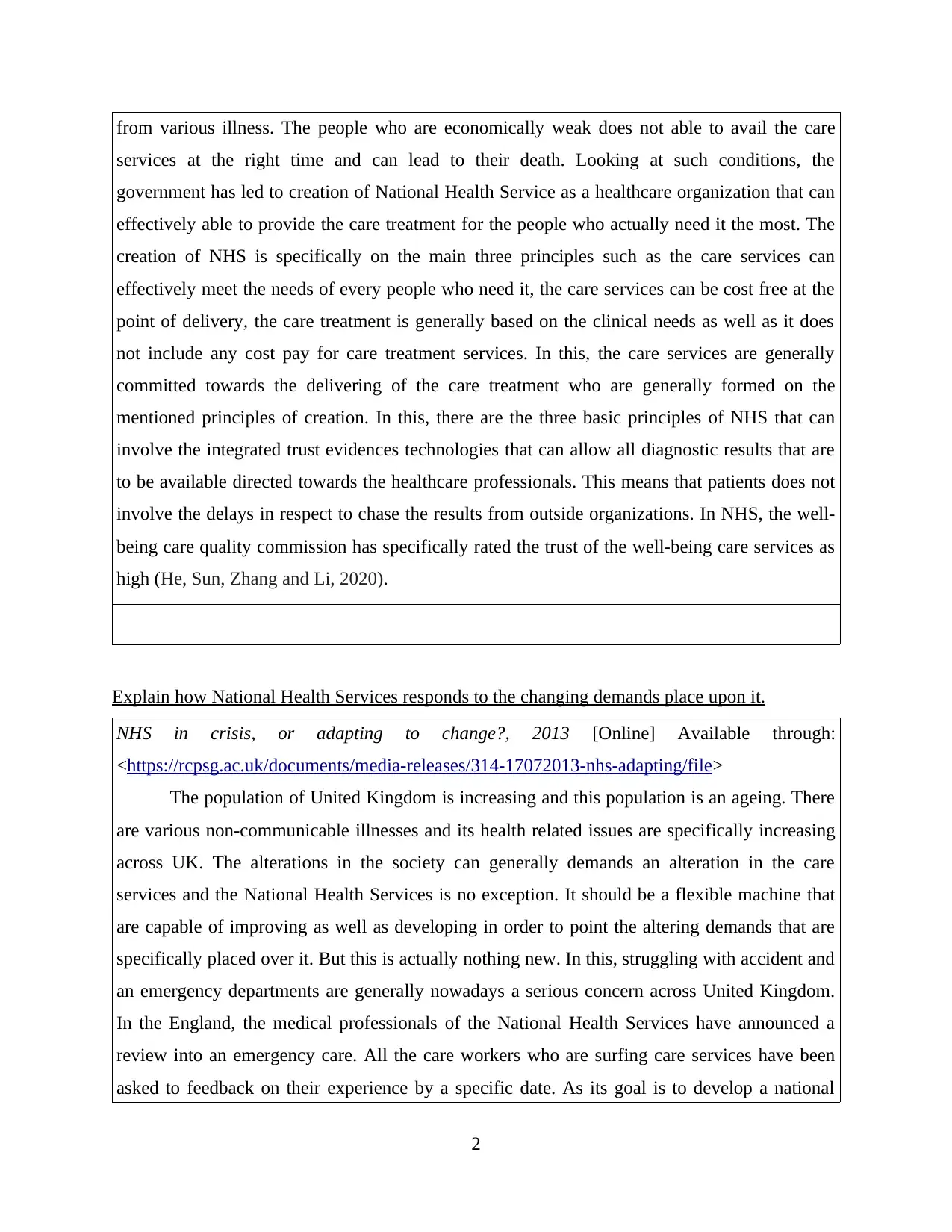
from various illness. The people who are economically weak does not able to avail the care
services at the right time and can lead to their death. Looking at such conditions, the
government has led to creation of National Health Service as a healthcare organization that can
effectively able to provide the care treatment for the people who actually need it the most. The
creation of NHS is specifically on the main three principles such as the care services can
effectively meet the needs of every people who need it, the care services can be cost free at the
point of delivery, the care treatment is generally based on the clinical needs as well as it does
not include any cost pay for care treatment services. In this, the care services are generally
committed towards the delivering of the care treatment who are generally formed on the
mentioned principles of creation. In this, there are the three basic principles of NHS that can
involve the integrated trust evidences technologies that can allow all diagnostic results that are
to be available directed towards the healthcare professionals. This means that patients does not
involve the delays in respect to chase the results from outside organizations. In NHS, the well-
being care quality commission has specifically rated the trust of the well-being care services as
high (He, Sun, Zhang and Li, 2020).
Explain how National Health Services responds to the changing demands place upon it.
NHS in crisis, or adapting to change?, 2013 [Online] Available through:
<https://rcpsg.ac.uk/documents/media-releases/314-17072013-nhs-adapting/file>
The population of United Kingdom is increasing and this population is an ageing. There
are various non-communicable illnesses and its health related issues are specifically increasing
across UK. The alterations in the society can generally demands an alteration in the care
services and the National Health Services is no exception. It should be a flexible machine that
are capable of improving as well as developing in order to point the altering demands that are
specifically placed over it. But this is actually nothing new. In this, struggling with accident and
an emergency departments are generally nowadays a serious concern across United Kingdom.
In the England, the medical professionals of the National Health Services have announced a
review into an emergency care. All the care workers who are surfing care services have been
asked to feedback on their experience by a specific date. As its goal is to develop a national
2
services at the right time and can lead to their death. Looking at such conditions, the
government has led to creation of National Health Service as a healthcare organization that can
effectively able to provide the care treatment for the people who actually need it the most. The
creation of NHS is specifically on the main three principles such as the care services can
effectively meet the needs of every people who need it, the care services can be cost free at the
point of delivery, the care treatment is generally based on the clinical needs as well as it does
not include any cost pay for care treatment services. In this, the care services are generally
committed towards the delivering of the care treatment who are generally formed on the
mentioned principles of creation. In this, there are the three basic principles of NHS that can
involve the integrated trust evidences technologies that can allow all diagnostic results that are
to be available directed towards the healthcare professionals. This means that patients does not
involve the delays in respect to chase the results from outside organizations. In NHS, the well-
being care quality commission has specifically rated the trust of the well-being care services as
high (He, Sun, Zhang and Li, 2020).
Explain how National Health Services responds to the changing demands place upon it.
NHS in crisis, or adapting to change?, 2013 [Online] Available through:
<https://rcpsg.ac.uk/documents/media-releases/314-17072013-nhs-adapting/file>
The population of United Kingdom is increasing and this population is an ageing. There
are various non-communicable illnesses and its health related issues are specifically increasing
across UK. The alterations in the society can generally demands an alteration in the care
services and the National Health Services is no exception. It should be a flexible machine that
are capable of improving as well as developing in order to point the altering demands that are
specifically placed over it. But this is actually nothing new. In this, struggling with accident and
an emergency departments are generally nowadays a serious concern across United Kingdom.
In the England, the medical professionals of the National Health Services have announced a
review into an emergency care. All the care workers who are surfing care services have been
asked to feedback on their experience by a specific date. As its goal is to develop a national
2
Paraphrase This Document
Need a fresh take? Get an instant paraphrase of this document with our AI Paraphraser
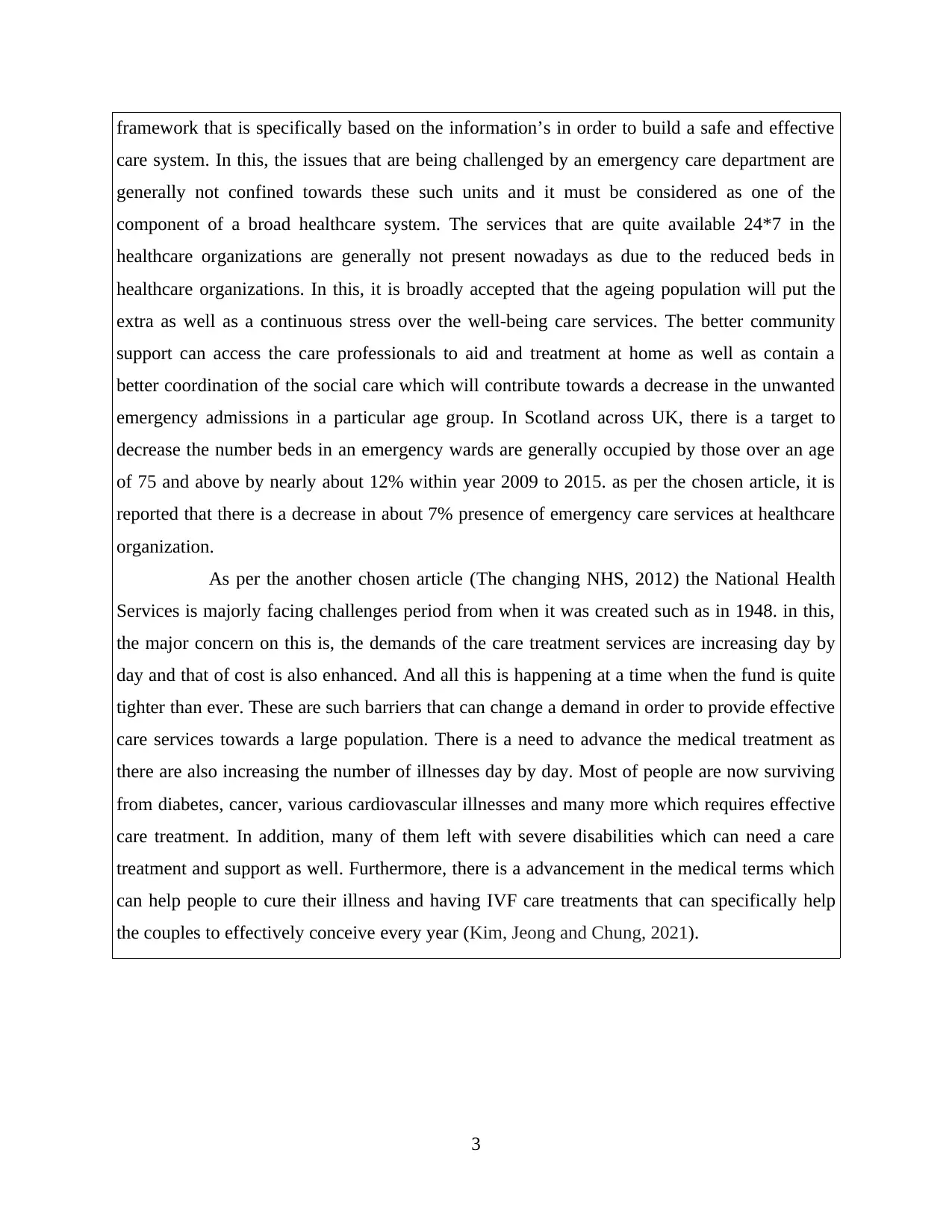
framework that is specifically based on the information’s in order to build a safe and effective
care system. In this, the issues that are being challenged by an emergency care department are
generally not confined towards these such units and it must be considered as one of the
component of a broad healthcare system. The services that are quite available 24*7 in the
healthcare organizations are generally not present nowadays as due to the reduced beds in
healthcare organizations. In this, it is broadly accepted that the ageing population will put the
extra as well as a continuous stress over the well-being care services. The better community
support can access the care professionals to aid and treatment at home as well as contain a
better coordination of the social care which will contribute towards a decrease in the unwanted
emergency admissions in a particular age group. In Scotland across UK, there is a target to
decrease the number beds in an emergency wards are generally occupied by those over an age
of 75 and above by nearly about 12% within year 2009 to 2015. as per the chosen article, it is
reported that there is a decrease in about 7% presence of emergency care services at healthcare
organization.
As per the another chosen article (The changing NHS, 2012) the National Health
Services is majorly facing challenges period from when it was created such as in 1948. in this,
the major concern on this is, the demands of the care treatment services are increasing day by
day and that of cost is also enhanced. And all this is happening at a time when the fund is quite
tighter than ever. These are such barriers that can change a demand in order to provide effective
care services towards a large population. There is a need to advance the medical treatment as
there are also increasing the number of illnesses day by day. Most of people are now surviving
from diabetes, cancer, various cardiovascular illnesses and many more which requires effective
care treatment. In addition, many of them left with severe disabilities which can need a care
treatment and support as well. Furthermore, there is a advancement in the medical terms which
can help people to cure their illness and having IVF care treatments that can specifically help
the couples to effectively conceive every year (Kim, Jeong and Chung, 2021).
3
care system. In this, the issues that are being challenged by an emergency care department are
generally not confined towards these such units and it must be considered as one of the
component of a broad healthcare system. The services that are quite available 24*7 in the
healthcare organizations are generally not present nowadays as due to the reduced beds in
healthcare organizations. In this, it is broadly accepted that the ageing population will put the
extra as well as a continuous stress over the well-being care services. The better community
support can access the care professionals to aid and treatment at home as well as contain a
better coordination of the social care which will contribute towards a decrease in the unwanted
emergency admissions in a particular age group. In Scotland across UK, there is a target to
decrease the number beds in an emergency wards are generally occupied by those over an age
of 75 and above by nearly about 12% within year 2009 to 2015. as per the chosen article, it is
reported that there is a decrease in about 7% presence of emergency care services at healthcare
organization.
As per the another chosen article (The changing NHS, 2012) the National Health
Services is majorly facing challenges period from when it was created such as in 1948. in this,
the major concern on this is, the demands of the care treatment services are increasing day by
day and that of cost is also enhanced. And all this is happening at a time when the fund is quite
tighter than ever. These are such barriers that can change a demand in order to provide effective
care services towards a large population. There is a need to advance the medical treatment as
there are also increasing the number of illnesses day by day. Most of people are now surviving
from diabetes, cancer, various cardiovascular illnesses and many more which requires effective
care treatment. In addition, many of them left with severe disabilities which can need a care
treatment and support as well. Furthermore, there is a advancement in the medical terms which
can help people to cure their illness and having IVF care treatments that can specifically help
the couples to effectively conceive every year (Kim, Jeong and Chung, 2021).
3
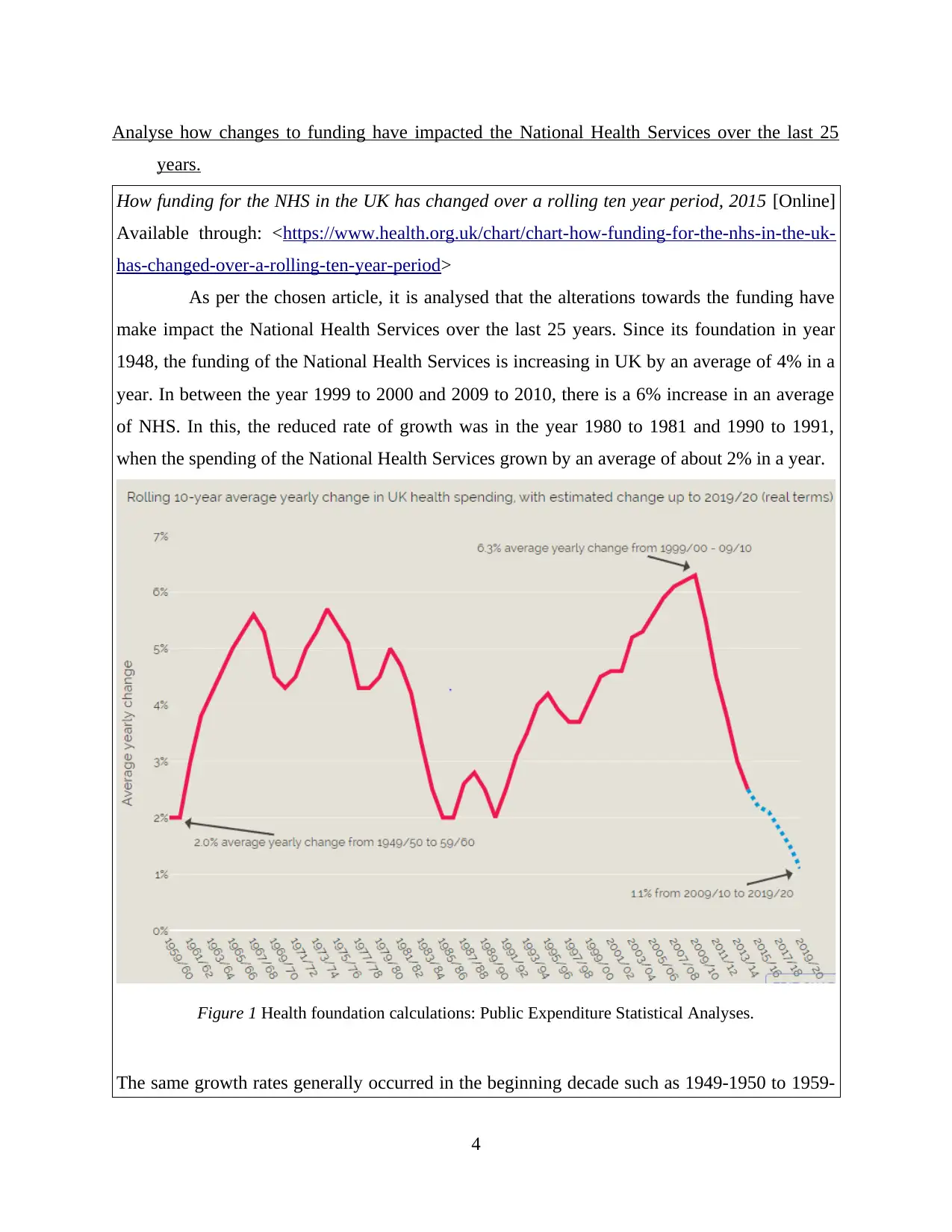
Analyse how changes to funding have impacted the National Health Services over the last 25
years.
How funding for the NHS in the UK has changed over a rolling ten year period, 2015 [Online]
Available through: <https://www.health.org.uk/chart/chart-how-funding-for-the-nhs-in-the-uk-
has-changed-over-a-rolling-ten-year-period>
As per the chosen article, it is analysed that the alterations towards the funding have
make impact the National Health Services over the last 25 years. Since its foundation in year
1948, the funding of the National Health Services is increasing in UK by an average of 4% in a
year. In between the year 1999 to 2000 and 2009 to 2010, there is a 6% increase in an average
of NHS. In this, the reduced rate of growth was in the year 1980 to 1981 and 1990 to 1991,
when the spending of the National Health Services grown by an average of about 2% in a year.
Figure 1 Health foundation calculations: Public Expenditure Statistical Analyses.
The same growth rates generally occurred in the beginning decade such as 1949-1950 to 1959-
4
years.
How funding for the NHS in the UK has changed over a rolling ten year period, 2015 [Online]
Available through: <https://www.health.org.uk/chart/chart-how-funding-for-the-nhs-in-the-uk-
has-changed-over-a-rolling-ten-year-period>
As per the chosen article, it is analysed that the alterations towards the funding have
make impact the National Health Services over the last 25 years. Since its foundation in year
1948, the funding of the National Health Services is increasing in UK by an average of 4% in a
year. In between the year 1999 to 2000 and 2009 to 2010, there is a 6% increase in an average
of NHS. In this, the reduced rate of growth was in the year 1980 to 1981 and 1990 to 1991,
when the spending of the National Health Services grown by an average of about 2% in a year.
Figure 1 Health foundation calculations: Public Expenditure Statistical Analyses.
The same growth rates generally occurred in the beginning decade such as 1949-1950 to 1959-
4
⊘ This is a preview!⊘
Do you want full access?
Subscribe today to unlock all pages.

Trusted by 1+ million students worldwide
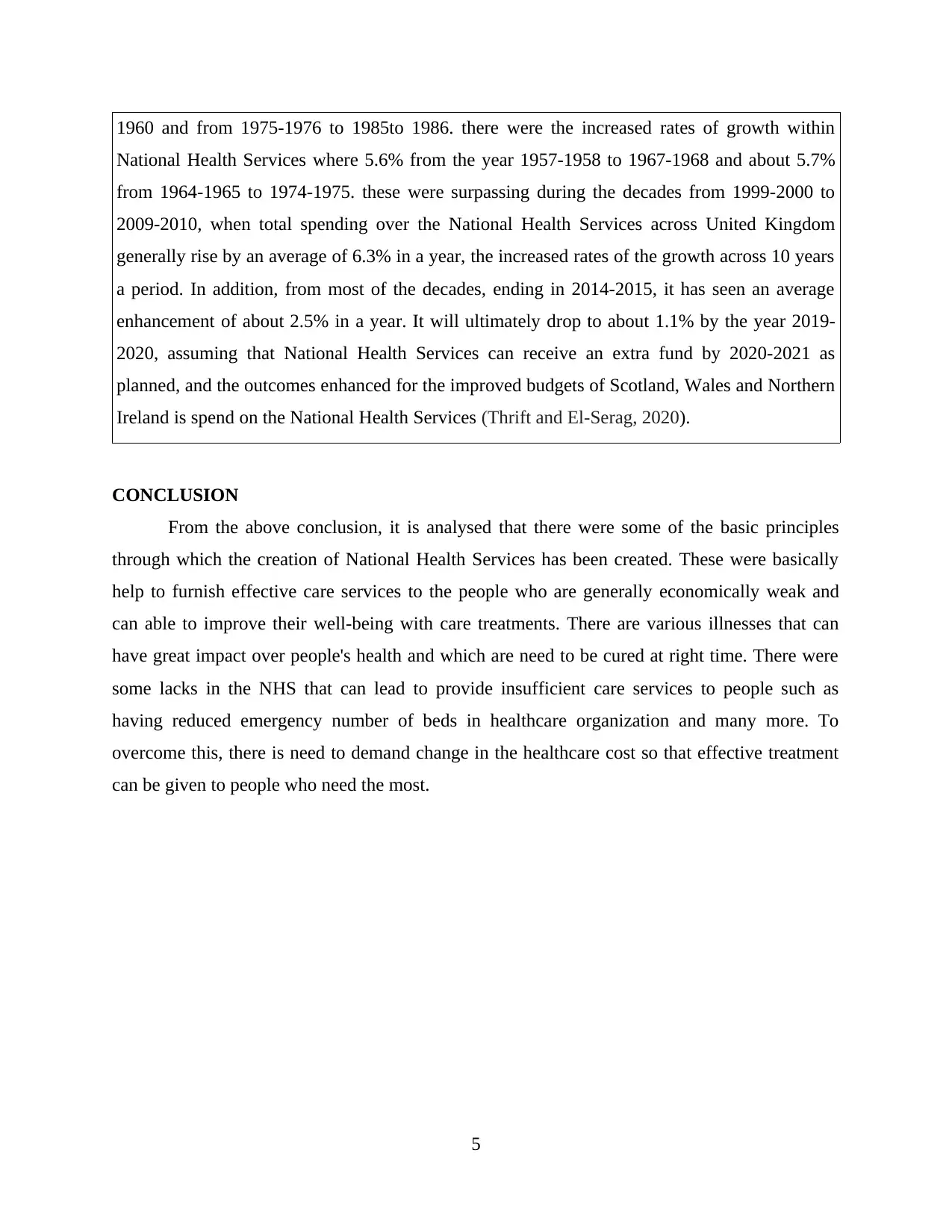
1960 and from 1975-1976 to 1985to 1986. there were the increased rates of growth within
National Health Services where 5.6% from the year 1957-1958 to 1967-1968 and about 5.7%
from 1964-1965 to 1974-1975. these were surpassing during the decades from 1999-2000 to
2009-2010, when total spending over the National Health Services across United Kingdom
generally rise by an average of 6.3% in a year, the increased rates of the growth across 10 years
a period. In addition, from most of the decades, ending in 2014-2015, it has seen an average
enhancement of about 2.5% in a year. It will ultimately drop to about 1.1% by the year 2019-
2020, assuming that National Health Services can receive an extra fund by 2020-2021 as
planned, and the outcomes enhanced for the improved budgets of Scotland, Wales and Northern
Ireland is spend on the National Health Services (Thrift and El-Serag, 2020).
CONCLUSION
From the above conclusion, it is analysed that there were some of the basic principles
through which the creation of National Health Services has been created. These were basically
help to furnish effective care services to the people who are generally economically weak and
can able to improve their well-being with care treatments. There are various illnesses that can
have great impact over people's health and which are need to be cured at right time. There were
some lacks in the NHS that can lead to provide insufficient care services to people such as
having reduced emergency number of beds in healthcare organization and many more. To
overcome this, there is need to demand change in the healthcare cost so that effective treatment
can be given to people who need the most.
5
National Health Services where 5.6% from the year 1957-1958 to 1967-1968 and about 5.7%
from 1964-1965 to 1974-1975. these were surpassing during the decades from 1999-2000 to
2009-2010, when total spending over the National Health Services across United Kingdom
generally rise by an average of 6.3% in a year, the increased rates of the growth across 10 years
a period. In addition, from most of the decades, ending in 2014-2015, it has seen an average
enhancement of about 2.5% in a year. It will ultimately drop to about 1.1% by the year 2019-
2020, assuming that National Health Services can receive an extra fund by 2020-2021 as
planned, and the outcomes enhanced for the improved budgets of Scotland, Wales and Northern
Ireland is spend on the National Health Services (Thrift and El-Serag, 2020).
CONCLUSION
From the above conclusion, it is analysed that there were some of the basic principles
through which the creation of National Health Services has been created. These were basically
help to furnish effective care services to the people who are generally economically weak and
can able to improve their well-being with care treatments. There are various illnesses that can
have great impact over people's health and which are need to be cured at right time. There were
some lacks in the NHS that can lead to provide insufficient care services to people such as
having reduced emergency number of beds in healthcare organization and many more. To
overcome this, there is need to demand change in the healthcare cost so that effective treatment
can be given to people who need the most.
5
Paraphrase This Document
Need a fresh take? Get an instant paraphrase of this document with our AI Paraphraser
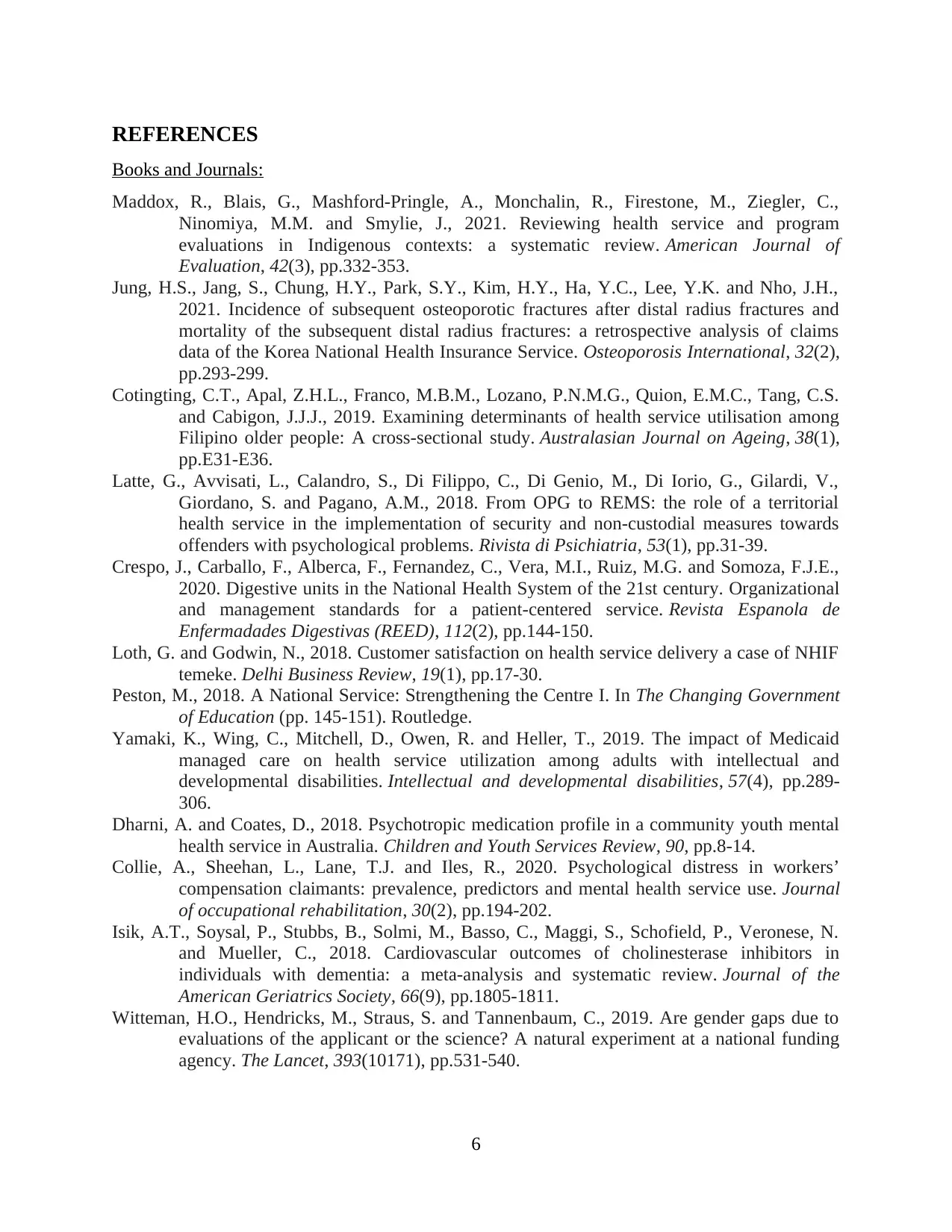
REFERENCES
Books and Journals:
Maddox, R., Blais, G., Mashford-Pringle, A., Monchalin, R., Firestone, M., Ziegler, C.,
Ninomiya, M.M. and Smylie, J., 2021. Reviewing health service and program
evaluations in Indigenous contexts: a systematic review. American Journal of
Evaluation, 42(3), pp.332-353.
Jung, H.S., Jang, S., Chung, H.Y., Park, S.Y., Kim, H.Y., Ha, Y.C., Lee, Y.K. and Nho, J.H.,
2021. Incidence of subsequent osteoporotic fractures after distal radius fractures and
mortality of the subsequent distal radius fractures: a retrospective analysis of claims
data of the Korea National Health Insurance Service. Osteoporosis International, 32(2),
pp.293-299.
Cotingting, C.T., Apal, Z.H.L., Franco, M.B.M., Lozano, P.N.M.G., Quion, E.M.C., Tang, C.S.
and Cabigon, J.J.J., 2019. Examining determinants of health service utilisation among
Filipino older people: A cross‐sectional study. Australasian Journal on Ageing, 38(1),
pp.E31-E36.
Latte, G., Avvisati, L., Calandro, S., Di Filippo, C., Di Genio, M., Di Iorio, G., Gilardi, V.,
Giordano, S. and Pagano, A.M., 2018. From OPG to REMS: the role of a territorial
health service in the implementation of security and non-custodial measures towards
offenders with psychological problems. Rivista di Psichiatria, 53(1), pp.31-39.
Crespo, J., Carballo, F., Alberca, F., Fernandez, C., Vera, M.I., Ruiz, M.G. and Somoza, F.J.E.,
2020. Digestive units in the National Health System of the 21st century. Organizational
and management standards for a patient-centered service. Revista Espanola de
Enfermadades Digestivas (REED), 112(2), pp.144-150.
Loth, G. and Godwin, N., 2018. Customer satisfaction on health service delivery a case of NHIF
temeke. Delhi Business Review, 19(1), pp.17-30.
Peston, M., 2018. A National Service: Strengthening the Centre I. In The Changing Government
of Education (pp. 145-151). Routledge.
Yamaki, K., Wing, C., Mitchell, D., Owen, R. and Heller, T., 2019. The impact of Medicaid
managed care on health service utilization among adults with intellectual and
developmental disabilities. Intellectual and developmental disabilities, 57(4), pp.289-
306.
Dharni, A. and Coates, D., 2018. Psychotropic medication profile in a community youth mental
health service in Australia. Children and Youth Services Review, 90, pp.8-14.
Collie, A., Sheehan, L., Lane, T.J. and Iles, R., 2020. Psychological distress in workers’
compensation claimants: prevalence, predictors and mental health service use. Journal
of occupational rehabilitation, 30(2), pp.194-202.
Isik, A.T., Soysal, P., Stubbs, B., Solmi, M., Basso, C., Maggi, S., Schofield, P., Veronese, N.
and Mueller, C., 2018. Cardiovascular outcomes of cholinesterase inhibitors in
individuals with dementia: a meta‐analysis and systematic review. Journal of the
American Geriatrics Society, 66(9), pp.1805-1811.
Witteman, H.O., Hendricks, M., Straus, S. and Tannenbaum, C., 2019. Are gender gaps due to
evaluations of the applicant or the science? A natural experiment at a national funding
agency. The Lancet, 393(10171), pp.531-540.
6
Books and Journals:
Maddox, R., Blais, G., Mashford-Pringle, A., Monchalin, R., Firestone, M., Ziegler, C.,
Ninomiya, M.M. and Smylie, J., 2021. Reviewing health service and program
evaluations in Indigenous contexts: a systematic review. American Journal of
Evaluation, 42(3), pp.332-353.
Jung, H.S., Jang, S., Chung, H.Y., Park, S.Y., Kim, H.Y., Ha, Y.C., Lee, Y.K. and Nho, J.H.,
2021. Incidence of subsequent osteoporotic fractures after distal radius fractures and
mortality of the subsequent distal radius fractures: a retrospective analysis of claims
data of the Korea National Health Insurance Service. Osteoporosis International, 32(2),
pp.293-299.
Cotingting, C.T., Apal, Z.H.L., Franco, M.B.M., Lozano, P.N.M.G., Quion, E.M.C., Tang, C.S.
and Cabigon, J.J.J., 2019. Examining determinants of health service utilisation among
Filipino older people: A cross‐sectional study. Australasian Journal on Ageing, 38(1),
pp.E31-E36.
Latte, G., Avvisati, L., Calandro, S., Di Filippo, C., Di Genio, M., Di Iorio, G., Gilardi, V.,
Giordano, S. and Pagano, A.M., 2018. From OPG to REMS: the role of a territorial
health service in the implementation of security and non-custodial measures towards
offenders with psychological problems. Rivista di Psichiatria, 53(1), pp.31-39.
Crespo, J., Carballo, F., Alberca, F., Fernandez, C., Vera, M.I., Ruiz, M.G. and Somoza, F.J.E.,
2020. Digestive units in the National Health System of the 21st century. Organizational
and management standards for a patient-centered service. Revista Espanola de
Enfermadades Digestivas (REED), 112(2), pp.144-150.
Loth, G. and Godwin, N., 2018. Customer satisfaction on health service delivery a case of NHIF
temeke. Delhi Business Review, 19(1), pp.17-30.
Peston, M., 2018. A National Service: Strengthening the Centre I. In The Changing Government
of Education (pp. 145-151). Routledge.
Yamaki, K., Wing, C., Mitchell, D., Owen, R. and Heller, T., 2019. The impact of Medicaid
managed care on health service utilization among adults with intellectual and
developmental disabilities. Intellectual and developmental disabilities, 57(4), pp.289-
306.
Dharni, A. and Coates, D., 2018. Psychotropic medication profile in a community youth mental
health service in Australia. Children and Youth Services Review, 90, pp.8-14.
Collie, A., Sheehan, L., Lane, T.J. and Iles, R., 2020. Psychological distress in workers’
compensation claimants: prevalence, predictors and mental health service use. Journal
of occupational rehabilitation, 30(2), pp.194-202.
Isik, A.T., Soysal, P., Stubbs, B., Solmi, M., Basso, C., Maggi, S., Schofield, P., Veronese, N.
and Mueller, C., 2018. Cardiovascular outcomes of cholinesterase inhibitors in
individuals with dementia: a meta‐analysis and systematic review. Journal of the
American Geriatrics Society, 66(9), pp.1805-1811.
Witteman, H.O., Hendricks, M., Straus, S. and Tannenbaum, C., 2019. Are gender gaps due to
evaluations of the applicant or the science? A natural experiment at a national funding
agency. The Lancet, 393(10171), pp.531-540.
6
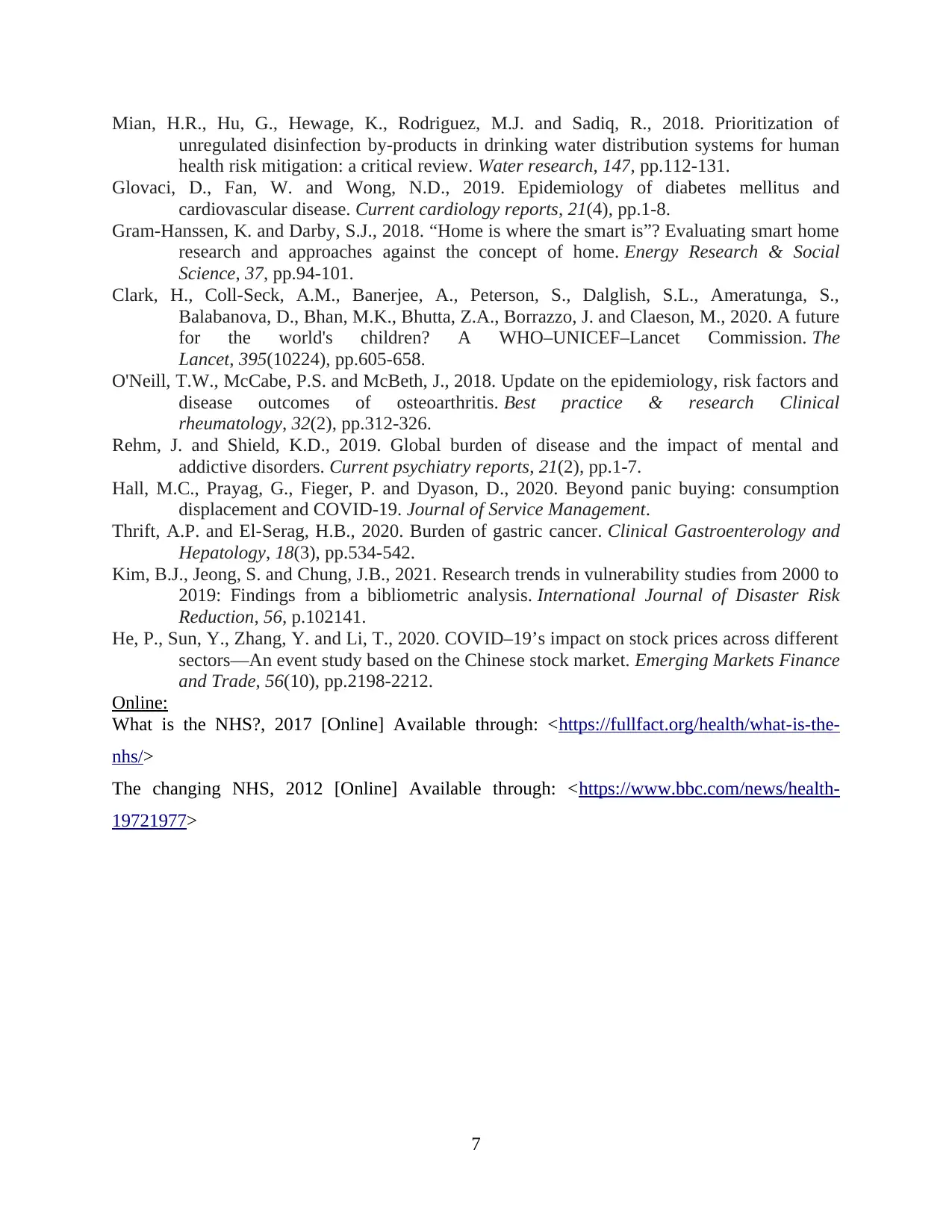
Mian, H.R., Hu, G., Hewage, K., Rodriguez, M.J. and Sadiq, R., 2018. Prioritization of
unregulated disinfection by-products in drinking water distribution systems for human
health risk mitigation: a critical review. Water research, 147, pp.112-131.
Glovaci, D., Fan, W. and Wong, N.D., 2019. Epidemiology of diabetes mellitus and
cardiovascular disease. Current cardiology reports, 21(4), pp.1-8.
Gram-Hanssen, K. and Darby, S.J., 2018. “Home is where the smart is”? Evaluating smart home
research and approaches against the concept of home. Energy Research & Social
Science, 37, pp.94-101.
Clark, H., Coll-Seck, A.M., Banerjee, A., Peterson, S., Dalglish, S.L., Ameratunga, S.,
Balabanova, D., Bhan, M.K., Bhutta, Z.A., Borrazzo, J. and Claeson, M., 2020. A future
for the world's children? A WHO–UNICEF–Lancet Commission. The
Lancet, 395(10224), pp.605-658.
O'Neill, T.W., McCabe, P.S. and McBeth, J., 2018. Update on the epidemiology, risk factors and
disease outcomes of osteoarthritis. Best practice & research Clinical
rheumatology, 32(2), pp.312-326.
Rehm, J. and Shield, K.D., 2019. Global burden of disease and the impact of mental and
addictive disorders. Current psychiatry reports, 21(2), pp.1-7.
Hall, M.C., Prayag, G., Fieger, P. and Dyason, D., 2020. Beyond panic buying: consumption
displacement and COVID-19. Journal of Service Management.
Thrift, A.P. and El-Serag, H.B., 2020. Burden of gastric cancer. Clinical Gastroenterology and
Hepatology, 18(3), pp.534-542.
Kim, B.J., Jeong, S. and Chung, J.B., 2021. Research trends in vulnerability studies from 2000 to
2019: Findings from a bibliometric analysis. International Journal of Disaster Risk
Reduction, 56, p.102141.
He, P., Sun, Y., Zhang, Y. and Li, T., 2020. COVID–19’s impact on stock prices across different
sectors—An event study based on the Chinese stock market. Emerging Markets Finance
and Trade, 56(10), pp.2198-2212.
Online:
What is the NHS?, 2017 [Online] Available through: <https://fullfact.org/health/what-is-the-
nhs/>
The changing NHS, 2012 [Online] Available through: <https://www.bbc.com/news/health-
19721977>
7
unregulated disinfection by-products in drinking water distribution systems for human
health risk mitigation: a critical review. Water research, 147, pp.112-131.
Glovaci, D., Fan, W. and Wong, N.D., 2019. Epidemiology of diabetes mellitus and
cardiovascular disease. Current cardiology reports, 21(4), pp.1-8.
Gram-Hanssen, K. and Darby, S.J., 2018. “Home is where the smart is”? Evaluating smart home
research and approaches against the concept of home. Energy Research & Social
Science, 37, pp.94-101.
Clark, H., Coll-Seck, A.M., Banerjee, A., Peterson, S., Dalglish, S.L., Ameratunga, S.,
Balabanova, D., Bhan, M.K., Bhutta, Z.A., Borrazzo, J. and Claeson, M., 2020. A future
for the world's children? A WHO–UNICEF–Lancet Commission. The
Lancet, 395(10224), pp.605-658.
O'Neill, T.W., McCabe, P.S. and McBeth, J., 2018. Update on the epidemiology, risk factors and
disease outcomes of osteoarthritis. Best practice & research Clinical
rheumatology, 32(2), pp.312-326.
Rehm, J. and Shield, K.D., 2019. Global burden of disease and the impact of mental and
addictive disorders. Current psychiatry reports, 21(2), pp.1-7.
Hall, M.C., Prayag, G., Fieger, P. and Dyason, D., 2020. Beyond panic buying: consumption
displacement and COVID-19. Journal of Service Management.
Thrift, A.P. and El-Serag, H.B., 2020. Burden of gastric cancer. Clinical Gastroenterology and
Hepatology, 18(3), pp.534-542.
Kim, B.J., Jeong, S. and Chung, J.B., 2021. Research trends in vulnerability studies from 2000 to
2019: Findings from a bibliometric analysis. International Journal of Disaster Risk
Reduction, 56, p.102141.
He, P., Sun, Y., Zhang, Y. and Li, T., 2020. COVID–19’s impact on stock prices across different
sectors—An event study based on the Chinese stock market. Emerging Markets Finance
and Trade, 56(10), pp.2198-2212.
Online:
What is the NHS?, 2017 [Online] Available through: <https://fullfact.org/health/what-is-the-
nhs/>
The changing NHS, 2012 [Online] Available through: <https://www.bbc.com/news/health-
19721977>
7
⊘ This is a preview!⊘
Do you want full access?
Subscribe today to unlock all pages.

Trusted by 1+ million students worldwide
1 out of 9
Related Documents
Your All-in-One AI-Powered Toolkit for Academic Success.
+13062052269
info@desklib.com
Available 24*7 on WhatsApp / Email
![[object Object]](/_next/static/media/star-bottom.7253800d.svg)
Unlock your academic potential
Copyright © 2020–2025 A2Z Services. All Rights Reserved. Developed and managed by ZUCOL.





